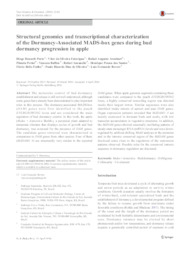Structural genomics and transcriptional characterization of the Dormancy-Associated MADS-box genes during bud dormancy progression in apple.
Structural genomics and transcriptional characterization of the Dormancy-Associated MADS-box genes during bud dormancy progression in apple.
Autoria: PORTO, D. D.; FALAVIGNA, V. da S.; ARENHART, R. A.; PERINI, P.; BUFFON, V.; ANZANELLO, R.; SANTOS, H. P. dos; FIALHO, F. B.; OLIVEIRA, P. R. D. de; REVERS, L. F.
Resumo: The molecular control of bud dormancy establishment and release is still not well understood, although some genes have already been demonstrated to play important roles in this process. The dormancy-associated MADS-box (DAM) genes were first identified in the peach EVERGROWING locus and are considered the main regulators of bud dormancy control. In this work, the apple (Malus × domestica Borkh.), a perennial plant adapted to temperate climates that displays cycles of growth and bud dormancy, was screened for the presence of DAM genes. The candidate genes retrieved were characterized in comparison to DAM genes from other species. Four of them (MdDAM1?4) are structurally very similar to the reported DAM genes. When apple genomic segments containing these candidates were compared to the peach EVERGROWING locus, a highly conserved noncoding region was detected inside their largest intron. Similar sequences were also identified inside introns of apricot and pear DAM genes. Organ expression patterns revealed that MdDAM1?4 are mainly expressed in dormant buds and seeds, with low transcript accumulation in vegetative structures. In addition, the MdDAM genes showed seasonally oscillating patterns of steady-state messenger RNA (mRNA) levels and were downregulated by artificial chilling. Motif analyses in the promoter and in the intronic conserved region of the MdDAM genes disclosed some clues to the regulation of the expression patterns observed. Possible roles for the conserved intronic sequence in dormancy regulation are discussed. Keywords Malus×domestica .Bud dormancy .DAMgenes . Collinearity . Cis-element
Ano de publicação: 2016
Tipo de publicação: Artigo de periódico
Unidade: Embrapa Semiárido
Palavras-chave: Apple, Bud dormancy, Cis-element, Collinearity, DAM genes, Genes DAM, Growth regulator, Malus domestica, Maçã, Quebra de dormência, Regulador de crescimento
Observações
1 - Por padrão são exibidas publicações dos últimos 20 anos. Para encontrar publicações mais antigas, configure o filtro ano de publicação, colocando o ano a partir do qual você deseja encontrar publicações. O filtro está na coluna da esquerda na busca acima.
2 - Para ler algumas publicações da Embrapa (apenas as que estão em formato ePub), é necessário ter, no celular ou computador, um desses softwares gratuitos. Sistemas Android: Google Play Livros; IOS: iBooks; Windows e Linux: software Calibre.
Acesse outras publicações
Acesse a Base de Dados da Pesquisa Agropecuária (BDPA) para consultar o acervo completo das bibliotecas da Embrapa.

